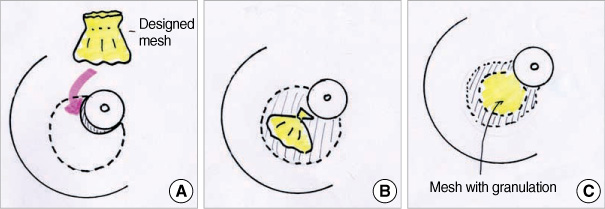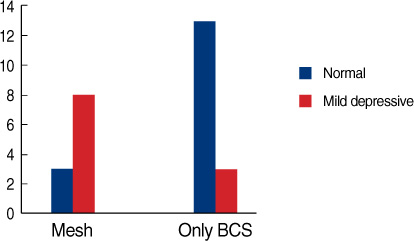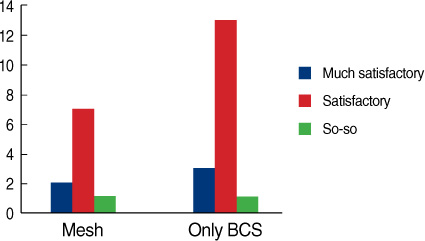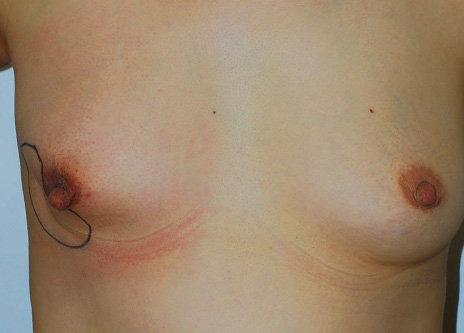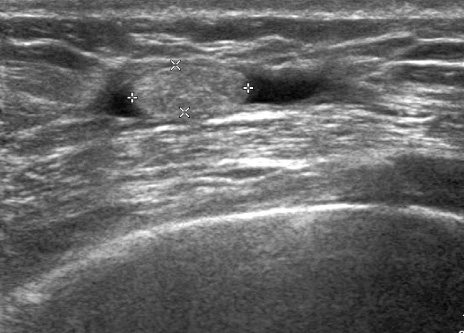Volume Replacement with Polyglactin 910 Mesh for Breast Reconstruction after Endoscopy-Assisted Breast Conserving Surgery for Treating Early Breast Cancer: the Early Results
- Affiliations
-
- 1Department of Surgery, Myongji Hospital, Kwandong University College of Medicine, Goyang, Korea. drgss@chol.com
- KMID: 2242011
- DOI: http://doi.org/10.4048/jbc.2009.12.3.193
Abstract
- PURPOSE
We introduce a new technique using a Vicryl(R) mesh made with Polyglactin 910 for breast reconstruction after performing endoscopy-assisted breast conserving surgery.
METHODS
From July 2006 to July 2008, we performed endoscopiy-assisted breast surgery in 30 patients with early breast cancer. (Thirty [fourteen] patients [who] underwent endoscopy-assisted breast conserving surgery). Of the total patients, 14 underwent reconstruction procedure (volume replacement with the use of a Vicryl(R) mesh) and 16 underwent reconstuction without Vicryl(R) mesh. We were evaluated for their quality of life (QOL), the surgery-related complications and the cosmetic outcomes. Three patients were excluded from the study; two patients required mesh removal due to infection and the other patient had a total mastectomy performed due to a positive resection margin.
RESULTS
The median age of the patient was 49.4 year (range 36-60 year) and all of the patients had a diagnosis of early breast cancer (less than stage IIb). In general, the patients were satisfied with the outcome for their QOL. The patients were especially satisfied with the cosmetic outcome. The patients' satisfaction increased with longer follow-up, as compared to that for the shorter intervals. At 10 months after surgery, there was encapsulated granulation tissue within a collection of tissue fluid, as seen on ultrasonography. At 20 months after surgery, the skin and breast shape both recovered.
CONCLUSION
The results of this study showed that for relatively short follow-up period, breast reconstruction with using Polyglactin 910 mesh, which is made from oxidized regenerated cellulose, resulted in satisfactory cosmetic results and a good quality of life after breast conservative surgery.
MeSH Terms
Figure
Cited by 5 articles
-
Results from Over One Year of Follow-Up for Absorbable Mesh Insertion in Partial Mastectomy
Min Young Koo, Se Kyung Lee, Sung Mo Hur, Soo Youn Bae, Min-Young Choi, Dong Hui Cho, Sangmin Kim, Jun-Ho Choe, Jung-Han Kim, Jee Soo Kim, Jeong Eon Lee, Seok Jin Nam, Jung-Hyun Yang
Yonsei Med J. 2011;52(5):803-808. doi: 10.3349/ymj.2011.52.5.803.Nationwide Survey of the Use of Absorbable Mesh in Breast Surgery in Korea
Ku Sang Kim, Man Young Park, Woo Jae Kim, Kuk Young Na, Yong Sik Jung, Young Jin Choi, Yong Lai Park, Se-Jeong Oh, Hyuk-Jae Shin,
J Breast Cancer. 2009;12(3):210-214. doi: 10.4048/jbc.2009.12.3.210.Endoscopy-assisted Breast Conserving Surgery for Breast Cancer: A Preliminary Clinical Experience
Young Ik Hong, Hyukjai Shin
J Breast Cancer. 2010;13(2):138-146. doi: 10.4048/jbc.2010.13.2.138.Analysis of Infections Occurring in Breast Cancer Patients after Breast Conserving Surgery Using Mesh
Jin Seong Cho, Sun Hyoung Shin, Ji Young Park, Young Ju Song, Jeong Min Yi, Min Ho Park, Jung Han Yoon, Young Jong Jegal, Ji Sin Yi, Seong Ja An, Hwo Soon Lim
J Breast Cancer. 2011;14(4):328-332. doi: 10.4048/jbc.2011.14.4.328.The Suitability of Absorbable Mesh Insertion for Oncoplastic Breast Surgery in Patients with Breast Cancer Scheduled to Be Irradiated
Taehyun Kim, Heunglae Cho
J Breast Cancer. 2013;16(1):84-89. doi: 10.4048/jbc.2013.16.1.84.
Reference
-
1. The Korean Breast Cancer Society. Nationwide Korean breast cancer data of 2004 using breast cancer registration program. J Breast Cancer. 2006. 9:151–161.2. Noguchi M, Taniya T, Miyazaki I, Saito Y. Immediate transposition of a latissimus dorsi muscle for correcting a postquadrantectomy breast deformity in Japanese patients. Int Surg. 1990. 75:166–170.3. Ohuchi N, Harada Y, Ishida T, Kiyohara H, Satomi S. Breast conserving surgery for primary breast cancer: immediate volume replace using lateral tissue flap. Breast Cancer. 1997. 4:59–65.4. Mark RJ, Zimmerman RP, Greif JM. Capsular contracture after lumpectomy and radiation therapy in patients who have undergone uncomplicated bilateral augmentation mammaplasty. Radiology. 1996. 200:621–625.
Article5. Berrino P, Campora E, Santi P. Postquadrantectomy breast deformities: classification and techniques of surgical correction. Plast Reconstr Surg. 1987. 79:567–572.6. Cooperman AM, Dinner M. The rhomboid flap and partial mastectomy. Surg Clin North Am. 1978. 58:869–873.
Article7. Raja MA, Straker VF, Rainsbury RM. Extending the role of breast-conserving surgery by immediate volume replacement. Br J Surg. 1997. 84:101–105.
Article8. Ho WS, Ying SY, Chan AC. Endoscopic-assisted subcutaneous mastectomy and axillary dissection with immediate mammary prosthesis reconstruction for early breast cancer. Surg Endosc. 2002. 16:302–306.
Article9. Sanuki J, Fukuma E, Wadamori K, Higa K, Sakamoto N, Tsunoda Y. Volume replacement with polyglycolic acid mesh for correcting breast deformity after endoscopic conservative surgery. Clin Breast Cancer. 2005. 6:175.
Article10. Nicholson RM, Leinster S, Sassoon EM. A comparison of the cosmetic and psychological outcome of breast reconstruction, breast conserving surgery and mastectomy without reconstruction. Breast. 2007. 16:396–410.
Article
- Full Text Links
- Actions
-
Cited
- CITED
-
- Close
- Share
- Similar articles
-
- Analysis of Infections Occurring in Breast Cancer Patients after Breast Conserving Surgery Using Mesh
- The Use of Absorbable Surgical Mesh after Partial Mastectomy for Improving the Cosmetic Outcome
- Results of Absorbable Mesh Insertion and Patient Satisfaction in Breast-Conserving Surgery
- Follow-Up after Volume Replacement Using Acellular Dermal Matrix in Oncoplastic Breast-Conserving Surgery
- Radiation Therapy for Patiens with Early-Stage Breast Carcinoma Treated with Breast-Conserving Surgery

